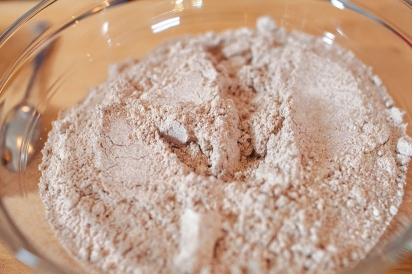Price Check on Aisle Five: Cricket Cookies - Wait What?
Edible insect products coming to a store near you
Bugs have a branding problem. Megan Miller, who founded Bitty Foods in 2013, is determined to change that. The former trend forecaster is on a mission to make U.S. consumers comfortable eating insects. She started with chocolate chip cricket cookies.
Have no fear, there’s not an insect leg or long antennae in sight: The crickets are dry-roasted and milled into a fine powder that evokes a neutral, nutty flavor with toasted grain notes.
Miller, whose media background comes in handy around product messaging, calls crickets “the gateway bug” to the edible insect trend and touts their nutritional benefits and eco-cred as a sustainable alternative protein source.
Until now, Bitty Foods has served as a niche, small-batch food producer, with a price point to match. The company manufactures cricket cookies and all-purpose flour. Both are available online and locally at Woodlands Markets in Kentfield and Tiburon. A bag of orange ginger cookies retails for $10 a dozen; the flour runs $20 for a 20-ounce bag. Miller makes muffins, pizza crust and other baked goods with the gluten-free, Paleo-friendly flour, a blend of cricket, cassava and coconut flours. Cricket-flour cobbler, anyone?
But Bitty Foods is poised for a major, mainstream market expansion. Almost a year ago, Miller and her co-founder Leslie Ziegler teamed up with celebrity chef Tyler Florence through his The Florence Group, which invested in the startup business. The Florence Group offers Bitty Foods expanded R&D capabilities, culinary expertise and access to distribution channels, along with a Marin-based brandname chef who is so gung ho about the potential of cricket-based food he signed on as the company’s culinary director.
Although the team was disclosing barely a chirp of specific details at press time, starting this summer, look for a gradual rollout of an expanded line of cricket-flour products from Bitty Foods, which may include savory snacks, energy bars and other meal replacement items, along with some tweaking of the original packaging and product line. The Florence Group works with large retailers such as Costco, Target and Williams-Sonoma, developing new lines including wine, cookware and food products, and will likely tap into those marketing channels to grow the budding bug business, one of several food startups it’s helping to incubate.
“That’s the secret sauce to getting our product out there,” says Miller, 37, who lives in San Francisco.
Florence first learned about Miller from a business partner after she gave a TEDx talk on eating insects in 2014 in New York. Bitty Foods makes sense to Florence from a culinary, environmental and product-development perspective.
“With limited resources, including water, the search for truly sustainable protein sources to feed people is a growing problem; it’s getting prohibitively expensive in the restaurant industry to put a steak on a plate,” says Florence, who owns the comfort-food-focused Wayfare Tavern in San Francisco. “Bitty Foods offers real solutions to this predicament.”
Florence is confident that the business can scale up and bring costs down once reliable sources of sustainably farmed crickets and consistent consumer demand is in place.
Eating insects isn’t a big deal in many cultures, including Mexico, as Florence notes, where all kinds of creepy crawlies are commonplace at farmers’ markets.
“When they’re dry-roasted, crickets have an earthy, whole-wheat-toast taste,” says the Food Network stalwart. “Some people just have to get over their antiseptic view about what’s edible and what isn’t,” adds Florence whose eponymously named Mill Valley kitchenware store and culinary class hub is slated to reopen as Tyler Florence Test Kitchen this summer following renovations. “In large parts of the world, insect consumption is commonplace. “There’s nothing off-putting about the flavor of crickets, they’re delicious.”
MILLER’S MEALWORM MOMENT
Miller’s first adventure in insect cookery proved a kitchen fail. In the fall of 2012, she started with mealworms she picked up from a local pet store. She tried baking the worms; that’s when she learned the creatures take on the flavor of whatever they eat. In this case, potting soil. Not so tasty. But when she fed them oat bran and apples, she was able to make mealworm bars that were, she says, quite appetizing.
She was psyched by her initial insect recipe success. And committed to doing more. Still, her fiancé took one look at the writhing, seething bowl of super worms and declined to take a bite of the bars. “That mealworm experience made me realize that those particular insects weren’t going to win the hearts and minds—or the taste buds—of most Americans,” she says. She quickly moved on to crickets.
It was not her first time chowing down on six-legged creatures. Backpacking through Southeast Asia she discovered whole markets devoted to selling edible insects. In addition to crickets, she tried grasshoppers, insect larvae and scorpions. More than a decade ago, in Oaxaca, Mexico, sipping a michelada, a beer-based drink similar to a Blood Mary, Miller asked a friend about the amazing spicy powder around the rim of the glass. Laced with maggots, it turned out. She’s been curious about insect gastronomy ever since.
More recently, Miller began reading up about the ecological impact and health halo of insect eating. A one-time entomology student, she became fascinated—even a bit obsessed, she says—about the potential health benefits and culinary applications of this sustainable alternative protein. She started out by co-founding a cricket company, Chirp Farms, in the summer of 2013. But she amicably parted ways with her company co-founder after several months to focus on cooking with crickets rather than raising them.
Soon after, she left a relatively secure position as the head of research and development for the global media company Bonnier AB to develop her gourmet line in the relatively untested market for consumer insect products. She hasn’t looked back.
Miller, who for a time followed the Paleo regimen, thought the grain-and gluten-free cookies would appeal to others of a similar dietary persuasion. Crickets are a good source of protein, calcium, iron, B vitamins and omega-3 fatty acids. One cup of Bitty Foods’ cricket flour, which requires about 4,000 crickets, provides 28 grams of protein.
But her biggest market to date has been decidedly more conventional. The largest sales come from Midwestern moms shopping for specialty foods online. Go figure.
Miller thinks Bitty Foods is on the cusp of breaking through. “I have long felt that if we could change the form factor with insects, and put them in delicious products with beautiful packaging, in foods that are familiar to people, then eating insects could catch on,” says Miller, who notes that about 80% of the world’s population already eats bugs. “It’s my goal to help make this cultural shift in the U.S. I want Bitty Foods to be an aspirational food sought out by thought leaders. But insect products also have the potential to become popular and accessible to all kinds of eaters.”
CREEPY-CRAWLY CUISINE: A FOOD INNOVATION WITH LEGS
Could insects be the next big thing on Western restaurant menus and grocery store aisles? Insects are already creeping into European and U.S. culinary circles. Chef René Redzepi of the innovative NOMA restaurant in Copenhagen has all kinds of fun with six-legged ingredients: fermented cricket paste, lemony wood-ants sprinkled on cabbage and creme fraiche, wax moth larvae mousse, cricket broth with grasshopper garum, and beeswax ice-cream. The Eat-a-Bug Cookbook by Seattle author David George Gordon features dishes like Three Bee Salad. Hollywood star Angelina Jolie made news when she announced that her worldly kids ate crickets like they were Doritos on a trip to Cambodia. Closer to home, San Francisco food cart Don Bugito creates a buzz with its insect offerings. Owner Monica Martinez, raised in Mexico City, serves insect street eats such as wax moth larvae taquitos, chocolate-covered salted crickets, and toffee mealworms over vanilla ice cream.
Bitty Foods does have competition in the retail space. The insect energy bar company Exo, founded by two Brown University alums, calls crickets the new kale. JetBlue offers Exo brand cricket-flour protein bars in flavors like peanut butter and jelly to passengers on JFK-to-LAX flights. Six Foods, a fledgling Boston-based snack company started by three Harvard grads, sells Chirps, a tortilla-style chip made with ground crickets. And back in 2012, the duo behind Chapul bars (think Clif Bars but with crickets and more exotic flavor pairings such as coconut, ginger and lime) turned to Kickstarter, as did Six Foods, to launch their bug-based business.
What do these products, including the ones made by Bitty Foods, have in common? Those buggy bits are hidden; camouflaging crickets and other insects, these food producers agree, is the best way to get U.S. consumers comfortable with grub-based food.
Insect eating has other champions. A 2013 United Nations Food and Agriculture Organization (FAO) report sang the praises of chirping crickets and other edible insects to help feed a hungry planet—predicted to hit 9 billion in population by 2050. The report, which garnered a ton of attention, is credited with helping propel interest in six-legged sources of alternative protein. The European Union recently committed around $4 million in research funds to figure out ways to make eating insects more palatable to Western diners. Clearly Chef Redzepi is doing his part to whet the appetite for bugs.
Insects are lauded as an eco-friendly alternative to raising livestock for food. Crickets emit 100 times fewer greenhouse gases than cattle; raising a pound of crickets requires one gallon of water and two pounds of feed, while raising a pound of beef requires 2,000 gallons of water and 25 pounds of feed, according to the FAO. And crickets take just six to eight weeks to reach maturity.
But not everyone is convinced of the planetary benefits of eating bugs: A new study in the journal Plos One concludes that the proteinconversion rate from the large-scale production of crickets for food isn’t much better than that of chickens, though Miller, for one, pokes holes in some of the research methodology in that report, claiming it’s flawed because the negative data is based on feeding crickets a diet with very little protein, and crickets need protein to thrive.
No doubt further research is needed to tease out the exact environmental impact of eating bugs. For now, insect producers are mostly concerned about supply. There simply aren’t enough cricket farms raising human-grade, organic crickets to meet the increasing demand. Five farms in the U.S. currently produce food-grade insects for a growing list of insect food companies.
Bitty Foods sources from Big Cricket Farms in Ohio, as well as companies in Austin, Texas, and Ontario, Canada. Tiny Farms, a startup in Oakland, is in the process of funding an industrial-scale insect farm, in an effort to help increase sustainable human-grade cricket production. Most mom-and-pop cricket companies grow for the pet food and fish bait market. Miller is also now working with cricket farmers in Sonoma County and the Central Valley, who used to grow for the pet food industry, to improve feed quality so they can sell crickets for human consumption. Interest in bug farming is clearly growing.
Supply challenges and customer conversion strategies are just hiccups on the way to scaling up, say the Bitty Food team. The way Florence, Miller and Ziegler see it, insect foods like their cricket-based products, currently produced at co-packing plants in Hayward and Vacaville, are a bright spot on the food innovation front. Potentially good news when the long-term outlook for animal protein is bleak.
“The future of protein is going to be based around water as well as other scarce resource concerns,” says Florence. “Insect food production is a super interesting category and it’s great to work on the ground incubating a young company and helping them get it right from the product to the packaging to the distribution to the storytelling. You want to take care with a cutting edge idea. It’s an exciting time to be involved with Bitty Foods.”












